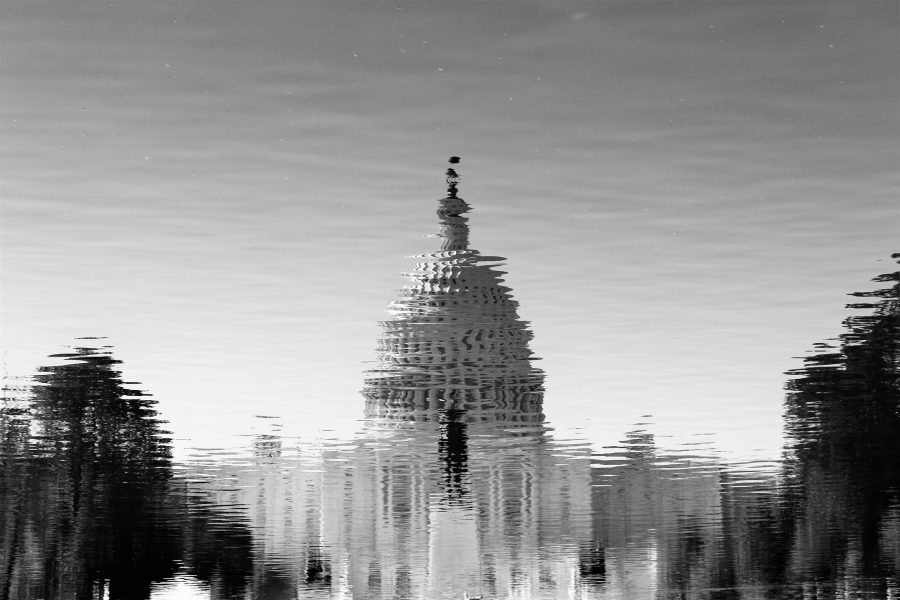President Trump’s schedule (EST):
12:00 PM: Daily intelligence briefing; and
12:30 PM: Lunch with Vice President Pence.
The Senate will return a 1 PM EST today to “resume consideration of the motion to proceed to S.1, Strengthening America’s Security in the Middle East Act of 2019.” Later this week, Majority Leader McConnell (R-KY) plans to take up President Trump’s proposal to end the shutdown, but the seven Democratic votes needed to end the Democratic filibuster aren’t there. The House will return at noon today with votes postponed until 6:30 PM EST on six bills from the Suspension Calendar. Later this week, it will take up another appropriations bill to reopen the government, H.R.648, which the Rules Committee will consider at 5 PM today.
“Chilling Davos: A Bleak Warning on Global Division and Debt.” This morning’s New York Times article cites billionaire investor Seth Klarman’s letter to clients, which has the world’s top investors buzzing. It included the following:
As the post-World War II international order continued to erode, the markets ignored the longer-term implications of a more isolated America, a world increasingly adrift and global leadership up for grabs. …
The seeds of the next major financial crisis (or the one after that) may well be found in today’s sovereign debt levels. There is no way to know how much debt is too much, but America will inevitably reach an inflection point whereupon a suddenly more skeptical debt market will refuse to continue to lend to us at rates we can afford. By the time such a crisis hits, it will likely be too late to get our house in order.
I couldn’t agree more.
“Pessimism Looms Over Prospect of a Sweeping China Trade Deal.” Yesterday’s New York Times article led with:
WASHINGTON — As a critical round of talks with China kicks off next week, the Trump administration is increasingly pessimistic that Beijing will make the kind of deep structural changes to its economy that the United States wants as part of a comprehensive trade agreement, according to officials involved with the talks.
The United States is now weighing whether large Chinese purchases of American goods and more modest economic changes will be enough for a deal to end a damaging trade war between the two nations and help calm volatile markets.
A Chinese delegation led by Liu He, China’s vice premier, will meet with Robert Lighthizer, the Trump administration’s top trade negotiator, and Steven Mnuchin, the Treasury secretary, on Jan. 30 and 31. The two countries are racing to strike an agreement by March 2, a deadline set by President Trump and President Xi Jinping of China.
If no deal is reached by that date, Mr. Trump has said the United States will raise tariffs on $200 billion worth of Chinese goods.
I’ve never expected a sweeping deal. I do expect the March 2 tariff hikes to be avoided and a phased future reduction of existing tariffs.
“Senate to Weigh Trump’s Proposal to End Shutdown, With Passage Unlikely.” Yesterday afternoon’s Wall Street Journal article led with:
WASHINGTON—The Senate this week is expected to vote on a border-security proposal put forward by President Trump that is unlikely to garner enough support to cross procedural hurdles, leaving no clear path forward as the partial government shutdown stretches into its fifth week.
The White House and Republican congressional leaders don’t appear to have crafted any contingency strategy if the president’s proposal fails a Senate vote.
“No idea,” one White House official said, asked about backup plans to end the shutdown. The White House didn’t respond to a request for comment.
Administration officials are working to end the shutdown, but the bad blood between President Trump and Speaker Pelosi continues to impede any progress. Both sides will continue talking past each other until both sides start getting blamed and public reaction forces a settlement.
“The Shutdown’s Impact on the Department of Treasury and American Taxpayers.” Thursday’s 10:30 AM House Ways and Means Committee hearing will feature Treasury Secretary Stephen Mnuchin trying to reassure skeptical Democrats that the IRS can pull of the tax filing season with half its workforce.
I’ll be looking to see how much, if any, damage the shutdown has done to the tax filing season will be admitted by Mr. Mnuchin. Delayed refunds, reduced and less accurate taxpayer assistance, inability to get anyone at the IRS to correct errors or restore stolen identities, inability to process some returns for which the regulations came out in December, and plummeting audits leading to more fraudulent filings are likely in my opinion. Some at the IRS have told me that, because most taxpayers file electronically, they’re hoping TurboTax and other tax software firms can save the day. I continue to expect total refunds to jump $73.5 b. February through May over last year’s level because most taxpayers haven’t adjusted their withholding or estimated payments. The IRS will report weekly statistics starting in February.
Expiring Tax Provisions Listed. Last Friday, in this 17-page pamphlet, the Joint Committee on Taxation listed 50 tax provisions that are scheduled to expire over the next decade and 3 that expired at the end of 2018 and 26 that expired at the end of 2017. It will be interesting to see how many, if any, are retroactively extended this year.
“Trump [Rx] Proposals Could Increase Health Costs for Consumers.” Yesterday’s New York Times article led with:
WASHINGTON — Consumers who use expensive brand-name prescription drugs when cheaper alternatives are available could face higher costs under a new policy being proposed by the Trump administration.
The proposal, to be published this week in the Federal Register, would apply to health insurance plans sold under the Affordable Care Act.
Health plans have annual limits on consumers’ out-of-pocket costs. Under the proposal, insurers would not have to count the full amount of a consumer’s co-payment for a brand-name drug toward the annual limit on cost-sharing. Insurers would have to count only the smaller amount that would be charged for a generic version of the drug.
For example, if a consumer filled a doctor’s prescription for a brand-name drug with a $25 co-payment, rather than using a generic medicine with a $5 co-payment, the consumer might get credit for only $5 in out-of-pocket spending. Consumers would have to spend more of their own money before reaching the annual limit on out-of-pocket costs.
In addition, insurers would not have to count the value of coupons and other financial assistance provided to consumers by drug manufacturers if generic alternatives were available. This change could significantly increase consumers’ out-of-pocket costs for some of the more expensive prescription drugs and has prompted protests from groups representing patients.
President Trump has repeatedly vowed to reduce drug prices and to lower out-of-pocket drug costs. But for some consumers, the latest proposal could have the opposite effect.
The proposal highlights a potential conflict between patients with a particular disease, who may benefit from the use of coupons, and other consumers more generally. Economists say that coupons can raise health care costs by encouraging people to use more expensive drugs.
“Housing Finance: Prolonged Conservatorships of Fannie Mae and Freddie Mac Prompt Need for Reform.” Last Friday’s 74-page Government Accountability Office report stated:
Federal support of the housing finance market remains significant even though the market has largely recovered since the 2007–2009 financial crisis. While down from the peak in 2009, in 2017, the federal government directly or indirectly guaranteed about 70 percent of single-family mortgage originations.
• The Federal National Mortgage Association (Fannie Mae) and the Federal Home Loan Mortgage Corporation (Freddie Mac)—two government- sponsored enterprises (enterprises) that purchase and securitize mortgages into mortgage-backed securities (MBS)—securitized and guaranteed about 46 percent of mortgage originations in 2017.
• In 2017, federal programs, such as those offered by the Federal Housing Administration (FHA), insured about 25 percent of mortgage originations.
Together, the enterprises and the Government National Mortgage Association (Ginnie Mae)—a federally owned corporation that guarantees MBS backed by federally insured mortgages—have issued or guaranteed 95 percent or more of all MBS issued annually since 2008 (see figure).
However, recent market trends pose risks to these entities and the housing finance system. For example, mortgage lending standards have loosened slightly in recent years, which could increase the risk of borrower default—especially in a recession or downturn in the housing market—and losses to federal entities. Nonbanks have increased their presence in mortgage lending and servicing, which involves collecting monthly mortgage payments, among other duties. For instance, the share of nonbank originations of FHA-insured mortgages increased from 56 percent in fiscal year 2010 to 86 percent in 2017. The share of nonbank servicers of mortgages in enterprise MBS also grew from 25 percent in 2014 to 38 percent as of the third quarter of 2018. While nonbank lenders and servicers have helped provide access to mortgage credit, they are not subject to federal safety and soundness regulations.
The Federal Housing Finance Agency (FHFA) has taken actions to lessen some of Fannie Mae and Freddie Mac’s risk exposure. For example, under FHFA’s direction, the enterprises have reduced the size of their riskier retained mortgage portfolios which hold assets that expose them to considerable interest rate and other risks from a combined $1.6 trillion in 2008 to $484 billion in 2017. Since 2013, the enterprises also have transferred increasing amounts of risk on their guaranteed MBS to private investors and insurers through credit risk transfer programs. However, federal fiscal exposure remains significant. The Department of the Treasury’s remaining funding commitment through the senior preferred stock purchase agreements—which provide financial support to the enterprises—leaves taxpayers exposed to risk, especially in the event of adverse market or other conditions and given the recent growth in the enterprises’ guarantee business. The value of outstanding MBS on which the enterprises guarantee principal and interest payments to investors grew from about $2.1 trillion in 2003 to about $4.8 trillion in 2017. The long duration of the conservatorships also raises uncertainty among market participants. Several experts and stakeholders GAO interviewed said that they have hesitated to make longer-term strategic plans and goals due to potential housing finance reforms that could markedly affect their industries. The figure below shows 2003–2017 trends in the enterprises’ guarantee business and retained mortgage portfolios.







